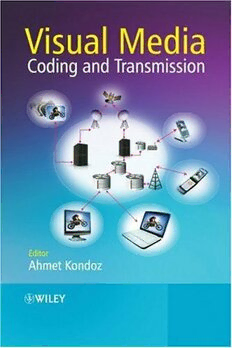Download Visual media coding and transmission PDF Free - Full Version
Download Visual media coding and transmission by Ahmet Kondoz in PDF format completely FREE. No registration required, no payment needed. Get instant access to this valuable resource on PDFdrive.to!
About Visual media coding and transmission
This book presents the state-of-the-art in visual media coding and transmission Visual Media Coding and Transmission is an output of VISNET II NoE, which is an EC IST-FP6 collaborative research project by twelve esteemed institutions from across Europe in the fields of networked audiovisual systems and home platforms. The authors provide information that will be essential for the future study and development of visual media communications technologies. The book contains details of video coding principles, which lead to advanced video coding developments in the form of Scalable Coding, Distributed Video Coding, Non-Normative Video Coding Tools and Transform Based Multi-View Coding. Having detailed the latest work in Visual Media Coding, networking aspects of Video Communication is detailed. Various Wireless Channel Models are presented to form the basis for both link level quality of service (QoS) and cross network transmission of compressed visual data. Finally, Context-Based Visual Media Content Adaptation is discussed with some examples. Key Features: Contains the latest advances in this important field covered by VISNET II NoE Addresses the latest multimedia signal processing and coding algorithms Covers all important advance video coding techniques, scalable and multiple description coding, distributed video coding and non-normative tools Discusses visual media networking with various wireless channel models QoS methods by way of link adaptation techniques are detailed with examples Presents a visual media content adaptation platform, which is both context aware and digital rights management enabled Contains contributions from highly respected academic and industrial organizations Visual Media Coding and Transmission will benefit researchers and engineers in the wireless communications and signal processing fields. It will also be of interest to graduate and PhD students on media processing, coding and communications courses.
Detailed Information
| Author: | Ahmet Kondoz |
|---|---|
| Publication Year: | 2009 |
| ISBN: | 470740574 |
| Pages: | 580 |
| Language: | English |
| File Size: | 13.503 |
| Format: | |
| Price: | FREE |
Safe & Secure Download - No registration required
Why Choose PDFdrive for Your Free Visual media coding and transmission Download?
- 100% Free: No hidden fees or subscriptions required for one book every day.
- No Registration: Immediate access is available without creating accounts for one book every day.
- Safe and Secure: Clean downloads without malware or viruses
- Multiple Formats: PDF, MOBI, Mpub,... optimized for all devices
- Educational Resource: Supporting knowledge sharing and learning
Frequently Asked Questions
Is it really free to download Visual media coding and transmission PDF?
Yes, on https://PDFdrive.to you can download Visual media coding and transmission by Ahmet Kondoz completely free. We don't require any payment, subscription, or registration to access this PDF file. For 3 books every day.
How can I read Visual media coding and transmission on my mobile device?
After downloading Visual media coding and transmission PDF, you can open it with any PDF reader app on your phone or tablet. We recommend using Adobe Acrobat Reader, Apple Books, or Google Play Books for the best reading experience.
Is this the full version of Visual media coding and transmission?
Yes, this is the complete PDF version of Visual media coding and transmission by Ahmet Kondoz. You will be able to read the entire content as in the printed version without missing any pages.
Is it legal to download Visual media coding and transmission PDF for free?
https://PDFdrive.to provides links to free educational resources available online. We do not store any files on our servers. Please be aware of copyright laws in your country before downloading.
The materials shared are intended for research, educational, and personal use in accordance with fair use principles.

